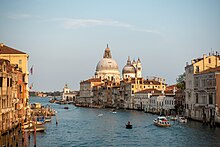
Back دول-مدن إيطالية Arabic Італьянскія гарады-дзяржавы Byelorussian Ciutats estat italianes Catalan Ciudades-estado italianas Spanish Città-stato italiane Italian De italienske bystatene NB Итальянские города-государства Russian İtalyan şehir devletleri Turkish Thành bang Ý Vietnamese 意大利城邦 Chinese
| History of Italy |
|---|
 |
|
|

The Italian city-states were numerous political and independent territorial entities that existed in the Italian Peninsula from antiquity to the formation of the Kingdom of Italy in the late 19th century.
The ancient Italian city-states were Etruscan (Dodecapolis), Latin, most famously Rome, and Greek (Magna Graecia), but also of Umbrian, Celtic and other origins. After the fall of the Western Roman Empire, urban settlements in Italy generally enjoyed a greater continuity than settlements in western Europe. Many of these cities were survivors of earlier Etruscan, Umbrian and Roman towns which had existed within the Roman Empire. The republican institutions of Rome had also survived.
Some feudal lords existed with a servile labour force and huge tracts of land, but by the 11th century, many cities, including Venice, Milan, Florence, Genoa, Pisa, Lucca, Cremona, Siena, Città di Castello, Perugia, and many others, had become large trading metropoles, able to obtain independence from their formal sovereigns. Some of these cities grew in importance and became duchies and maritime empires.